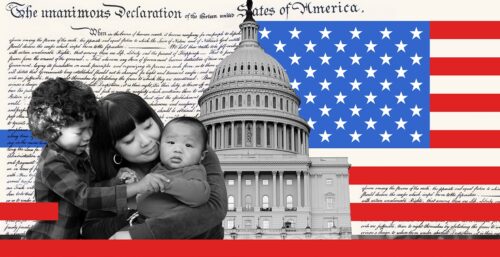Under S. 744, “The Border Security, Economic Opportunity, and Immigration Modernization Act,” a merit-based point system is proposed as a tool to allocate a portion of new immigrant visas each year. After this new system becomes effective, a minimum of 120,000 foreign-born people would be able to obtain immigrant visas each year by accumulating points mainly based on their skills, employment history, and education credentials. At the same time, visa slots currently allocated to siblings and adult married children of U.S. citizens, as well as the diversity visa program, would be absorbed into this new system.
An evaluation of the point system requires an understanding of several different assumptions made by the drafters. First, in reallocating visas, does the new point system provide access to individuals currently eligible to enter the U.S. under the eliminated sibling and visa diversity lottery categories? If not, what does that say about the assumptions behind the proposal? Second, within the allocation of points awarded to individual applicants, what characteristics are favored and how does that affect the likelihood that different groups will be able to make use of the point system to enter the United States? At its core, the allocation of points is not a neutral act, but instead reflects a political view regarding the “desired immigrant.” While the bill overall continues to privilege family and employment-based immigration, the effort to create a “merit” system may actually be at odds with core values that the United States has traditionally embraced (in particular, the defense of equality of opportunity, the fight against discrimination of all sorts, the protection of minorities and traditionally disadvantaged groups, and the preservation of families).
A preliminary analysis reveals clear signs that the new point system would put some categories of people at a disadvantage. Specifically, women, people who work in the informal economy (including those who do unpaid work), individuals with family ties to U.S. citizens with insufficient human capital credentials (i.e., formal education and employment history), middle age and older adults, and applicants from less-developed countries would be counted among those groups. The problems identified in this analysis raise concerns not only about the technical design of the point system, but the structure of values upon which the proposed new system is based. These concerns suggest that, before eliminating existing visa categories and replacing them with others, we must carefully explore the impacts of the new program through pilot studies and other efforts to determine whether a point system can meet the needs of the nation.
What are point systems and how do they work?
- Point-based immigration systems are immigration-management tools used to determine who is eligible to enter the host country. Variations of point systems are already used in some countries such as Canada, the United Kingdom, Australia, and New Zealand.
- In every country that uses point systems, these tools are used in addition to other immigration-management systems which are often based on family relationships, humanitarian concerns, or other employment-based systems.
- Point systems are based on a list of characteristics that a country finds valuable, such as education, occupation, work experience, language ability, or age.
- After determining all desired characteristics and point values, a country sets the total number of points that a person would need before being allowed to enter the host country; this is called the “pass mark.”
- In 2007, S. 1348 (the “Secure Borders, Economic Opportunity and Immigration Reform Act”) proposed a complex point system that relied on a combination of factors, including education, job skills, English proficiency, and family ties. The proposed system was widely criticized because it favored educated, high-skilled immigrants at the expense of less-skilled workers. Critics also asserted that the system would have favored certain regions over others (in particular, it would have put immigrants from Latin America at a disadvantage).
What are the specifics of the point system included in the “Border Security, Economic Opportunity, and Immigration Modernization Act’’?
- Between 120,000 and 250,000 visas would be allocated each year based on the point system.
- Beginning in the 5th fiscal year after the enactment of the bill, the Department of Homeland Security (DHS) would allocate merit-based visas in two “tiers”:
- 50% to applicants with the highest number of points allocated under tier 1 (see fig.1)
- 50% to applicants with the highest number of points allocated under tier 2 (see fig. 2)
- There is no “pass mark” specified in the bill.
- The allocation of points in both tiers is based on a combination of factors, including education, employment, occupation, civic involvement, English language proficiency, certain family ties, age, and nationality. Unlike the 2007 proposal, the 2013 proposal contains 2 tiers (one for high-skilled, and the other one for less-skilled workers).
- The way in which points are distributed, however, does not value each of these characteristics evenly. In fact, the system heavily favors employment and educational factors. Under tier 1, for example, the highest score an applicant can get is 100 points. The distribution of those points is as follows:
Snapshot of Tier 1 (High-Skilled)
|
Characteristic |
Maximum # of points |
|---|---|
|
Formal education |
15 |
|
Employment and entrepreneurship |
50 |
|
Civic involvement |
2 |
|
English language |
10 |
|
Siblings and married sons and daughters of U.S. citizens over 31 |
10 |
|
Age (Favors youth) |
8 |
|
National of country with low immigration to the U.S. |
5 |
- The message of this distribution is very clear: it prioritizes educated, experienced, skilled, English-fluent, young immigrants. The inclusion of family ties and diversity in this system, on the other hand, seems more like an extra bonus than an attribute that the system aims to embrace. Only 10 points of a total of 100 are assigned based on family ties. Nationals of countries with low immigration to the United States only receive 5 points.
- Under tier 2, the highest possible score is 85, and the point allocation is as follows:
Snapshot of Tier 2 (Less-Skilled)
|
Characteristic |
Maximum # of points |
|---|---|
|
Employment background |
40 |
|
Primary caregiver |
10 |
|
Civic involvement |
2 |
|
English language |
10 |
|
Siblings and married sons and daughters of U.S. citizens over 31 |
10 |
|
Age |
8 |
|
National of country with low immigration to the U.S. |
5 |
- Unlike tier 1, under tier 2 formal education is not included as a criterion for point allocation. Employment experience (especially in certain occupations that are in high demand or in less-skilled occupations) is the characteristic most strongly valued by this system. If we add language skills to that, we notice that human capital attributes receive almost 60% of the points available. Primary caregivers, who will be unlikely to earn any of the other employment-based points, are assigned 10 points. Applicants with certain family ties only receive 10 points out of 85. Being from a country with low immigration to the United States only allows you to earn 5 points. Again a system that does not embrace family ties or diversity.
Implications of the point system
- As established in the bill, this system is overwhelmingly guided by economic criteria. Potential immigrants are largely valued in terms of their supposed human-capital attributes and, therefore, their theoretical capacity to produce economic value. While the formal credentials of human capital are important, the overwhelming weight assigned to these characteristics may leave out some very valuable groups of people.
- The system raises concerns about its potential gender bias. Women who in some countries have less access to education and work opportunities than men would be systematically excluded from these channels. The system makes an attempt to acknowledge this situation by allocating points for caregivers (who for the most part tend to be women) under tier 2. However, the maximum number of points available for primary caregivers is 10. If caregivers have to compete with applicants who have been employed in the labor market and can accumulate up to 40 points through different categories, the playing field for these women is anything but level.
- Even if we adhere to the purely economic rationale upon which this new system is based, the potential contributions of women who work in the care economy are not adequately valued. Immigrant women who perform their work in the domestic sphere help sustain the current workforce, raise the future workforce, care for the elderly and sick, and play a critical role in household well-being. Their contributions to the economy are, therefore, not only immediate, but will also be felt in the future.
- Family ties are downplayed in this system. Because siblings or adult sons and daughters of U.S. citizens can only earn 10 points based on those ties, having these types of family connections will not really make a difference. Even though it has been demonstrated that families expedite the social and economic incorporation of newcomers, this element is not sufficiently acknowledged in the design of this new system. In particular, ethnic communities and families operate as sources of critical resources for new immigrants (e.g., opportunities for employment, credit, and support).
- Immigrant women’s participation in the labor force is facilitated by the presence in the home of other relatives. In other words, when other family members (such as parents or siblings) can take care of everyday household needs, women are more likely to participate in the labor market. In addition, unpaid health and child care provided in the household largely by immigrant women contribute to the physical, cognitive, and emotional development of household members. Those contributions are instrumental not only in individual well-being, but also in the human development of the country.
- The assignment of points based on age also raises concern regarding the moral and practical implications of age discrimination. The United States has evolved into a country that stands out in the world for its standards of inclusion and civil-rights protection, and for fighting discrimination of all sorts. However, this bill seems to go against the values that are embedded in domestic policy. By privileging younger cohorts over older ones, this system reduces the chances of admission for people who, because of their age, have built more experience, knowledge, and wisdom. This certainly does not reflect core American values.
- This point system may also result in a nationality bias, which will be translated into a systematic exclusion of immigrants from countries with lower levels of human capital. The diversity component, which has been an important part of the U.S. immigration system for more than twenty years, will—under this bill—be terminated for good. The 5 points that applicants can earn if they come from countries with low levels of migration to the U.S. do not seem to be sufficient to undo the structural barriers that prevent applicants from earning points under the other categories.
Who is at a disadvantage under the point system?
- There are clear signs that the new point system will put some categories of people at a disadvantage. Specifically, women, people who work in the informal economy (including those who do unpaid work), individuals with family ties to U.S. citizens with insufficient human-capital credentials, middle age and older adults, and applicants from less-developed countries can be counted among those groups.
- Therefore, leaping into a new system that has not been studied or piloted is not sound policy-making. Instead, to the degree that politicians believe a point system is a necessary component of a “grand bargain” on immigration, it should be done in ways that do not undermine groups that are already disadvantaged by the current immigration system. The most feasible way to do this would be to create a pilot point system and over the trialperiod work to modify it until we find the right balance of characteristics and requirements.
Full Details of Merit-based points track one for High & Less Skilled Immigrants
|
Worldwide level |
|
||
|
Fiscal years 1 through 4 |
Beginning after enactment of bill, worldwide level of merit-based visas should be made available to those in the 203(b)(3) category (Skilled workers, professionals, and other workers) |
||
|
Beginning in the 5th fiscal year |
DHS will allocate merits-based visas between two tiers:
|
||
|
Tier 1- Point allocation |
Education (alien may receive points only for highest degree)
|
15 points 10 points 5 points |
|
|
Employment (20 points maximum)
|
3 points
2 points |
||
|
Employment related to education
|
10 points 8 points |
||
|
Entrepreneurship
|
10 points |
||
|
High demand occupation
|
10 points |
||
|
Civic involvement
|
2 points |
||
|
English language TOEFL score of 80 or more |
10 points |
||
|
Siblings and married sons and daughters of U.S. citizens over 31 |
10 points |
||
|
Age
|
8 points 6 points 4 points |
||
|
Country of origin
|
5 points |
||
|
Tier 2- Point allocation |
Employment experience (20 points maximum)
|
2 points |
|
|
Special employment criteria
|
10 points 10 points |
||
|
Caregiver
|
10 points |
||
|
Exceptional employment record
|
10 points |
||
|
Civic involvement
|
2 points |
||
|
English language
|
10 points 5 points |
||
|
Siblings and married sons and daughters of citizens over 31 |
10 points |
||
|
Age
|
8 points 6 points 4 points |
||
|
Country of origin
|
5 points |
||



